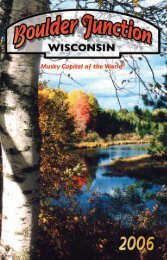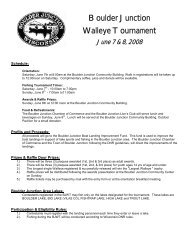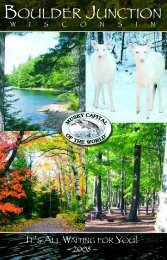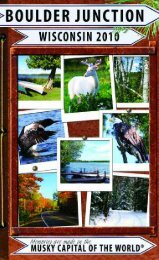BJ Book - Boulder Junction
BJ Book - Boulder Junction
BJ Book - Boulder Junction
Create successful ePaper yourself
Turn your PDF publications into a flip-book with our unique Google optimized e-Paper software.
A Brief History<br />
The Milwaukee Road<br />
railroad tracks first<br />
reached the area in<br />
1903, but it was December<br />
1905 before the name<br />
“<strong>Boulder</strong> <strong>Junction</strong>” first<br />
appeared in the Chicago/<br />
Milwaukee & St. Paul<br />
railway timetable. Immediate -<br />
ly, hunters and anglers began<br />
visiting the area and camping<br />
on several nearby lakes.<br />
Prior to the 1903 arrival<br />
of the railroad ,getting to the<br />
area involved renting a team<br />
of horses in Woodruff, followed by an arduous, allday<br />
wagon ride. A far cry from today’s 20-mile drive<br />
up Hwy. 51 and Cty. M!<br />
The first downtown structure was Paquette’s<br />
Hotel & Saloon, built in 1911. Tourism and logging<br />
grew side-by-side, sharing the life-line that the<br />
railroad provided. Among the first resorts to be<br />
opened were Coon’s on Trout Lake; McKinley on<br />
Wolf Lake (now part of the private Dairyman’s<br />
Country Club); and Rabbit’s Foot Resort on <strong>Boulder</strong><br />
Lake (now Camp Manito-wish YMCA).<br />
Among the first structures built by the railroad<br />
were a small depot, a coal shed, and a house for the<br />
section foreman and his family. Today’s wide Main<br />
Street is a result of the rail buildings, lines, spurs and<br />
sidings.<br />
Phone service came to <strong>Boulder</strong> <strong>Junction</strong> in 1925<br />
and electricity came to the town in 1930.<br />
Unfortunately, the previous busy railroad operation<br />
slowed considerably in 1931, and the last train pulled<br />
out of <strong>Boulder</strong> <strong>Junction</strong> in 1932.<br />
<strong>Boulder</strong> <strong>Junction</strong> was officially incorporated as a<br />
town in March 1927, when it separated from Arbor<br />
Vitae. In those days, the town hall performed<br />
multiple functions – it was a school midweek, a dance<br />
hall on Saturday nights and a church on Sunday.<br />
In 1933 the state of Wisconsin began a<br />
vigorous re-afforestation program, through the<br />
formation of the Civilian Conservation Corps.<br />
Thanks to the CCC’s establishment of seedling<br />
production, planting greatly intensified. The forests<br />
would soon return, in stark contrast to the 1910<br />
landscape which was nearly denuded of trees by the<br />
logging operations conducted between the 1890s and<br />
1910. As the forest grew, so too, would tourism.<br />
page 6







